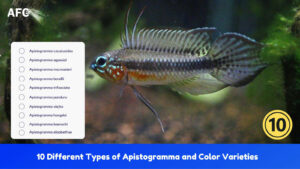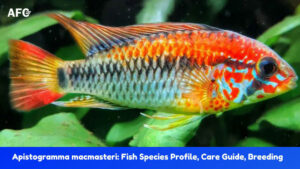With over 1,000 species of cichlid fish living in Lake Malawi, it’s no wonder it is one of the most diverse lakes on earth. Lake Malawi Cichlids are probably the most popular type of fish in an aquarium; They’re known for their vibrant coloration and patterning, variety in body shapes, and a vast range of sizes.
Utaka cichlids, as one of the residents of Lake Malawi, are not as popular as their neighbors, like the haps and the mbuna, due to their very neutral gray colors. However, many species are relatively more peaceful and spectacularly colorful as compared to the Mbuna in the home aquarium.
Although Utaka cichlids are not the most aggressive African cichlids, they make up for it in terms of free-swimming nature, and it is never an easy task to keep them happy and healthy.
That’s why we put this guide together with all the information and knowledge needed on caring for Utaka cichlids, including their species, food, tank mates, and more!
Species Summary

First of all, let’s talk about the name “Utaka”. The name Utaka is taken from one of the local languages spoken around Lake Malawi, referred to as ‘semipelagic’, which means fish that spend part of their life on the bottom and part in the water column above.
There has been some controversy surrounding the Utaka cichlid caused by the historical explanation – they were classified as a species of Haplochromis. You can also find that they are described as “open-water haps endemic to Lake Malawi’ or “non-mbuna species from the Lake Malawi”.
Well, all of the descriptions are true to an extent, they’re not completely accurate. Scientifically speaking, Utaka is any member of the genera Copadichromis and Mchenga in Lake Malawi.
Full List of Recognized Utaka Species
Below is the full list of recognized species in those two Lake Malawi cichlid genera.
| Genus | Species |
|---|---|
| Copadichromis | Copadichromis atripinnis Copadichromis azureus Copadichromis borleyi Copadichromis chizumuluensis Copadichromis chrysonotus Copadichromis cyaneus Copadichromis cyanocephalus Copadichromis diplostigma Copadichromis geertsi Copadichromis ilesi Copadichromis insularis Copadichromis jacksoni Copadichromis likomae Copadichromis mbenjii Copadichromis mela Copadichromis mloto Copadichromis nkatae Copadichromis parvus Copadichromis pleurostigma Copadichromis pleurostigmoides Copadichromis quadrimaculatus Copadichromis trewavasae Copadichromis trimaculatus Copadichromis verduyni Copadichromis virginalis |
| Mchenga | Mchenga conophoros Mchenga cyclicos Mchenga eucinostomus Mchenga flavimanus Mchenga inornata Mchenga thinos |
Appearance and Size
Unlike mbuna, the most beautiful, active cichlids from birth in Lake Malawi, the Utaka Cichlids are naturally born plain and grey until they reach adulthood. This evolutionary appearance helps them blend into the surroundings to make them less visible as prey.
You will have to wait for them to mature to see their brilliant colorations. However, there is a big difference between adult females and males — males are usually brighter and more vivid while females remain bland.
Some Utaka Cichlids can get quite large, require a large area of open water, and are not really suitable for aquariums. But a few smaller types have been bred in captivity thanks to their stunning appearance that makes them popular with hobbyists.
Behavior & Temperament
As opposed to the most common Mbuna that dwells among rocks along the lake’s fringes and bottom, the Utaka inhabits open water areas; some species live above sandy shores, like Mchenga conophoros. Most tend to stay within a short distance from the cliffs.
In the open water, they form large schools that can be composed of multiple species and contain thousands or even millions of individual fish.
As mentioned earlier, Utaka cichlids are one of the more peaceful fish, making them an excellent choice for those who do not like aggression issues.
Aquarium Setup
The Utaka is a unique group that has been collected from Lake Malawi since the early 1990s. These fish can live more than 15 years in captivity.
With the water parameters being so flexible, it is easy to mimic the living conditions of other Malawi cichlids.
Water Conditions
The streams and rivers that flow into Lake Malawi are very high in minerals, along with a high rate of evaporation, which has resulted in a high pH, KH, and GH chemistry in the water.
Providing an optimal level of care is always essential. Here are the water parameters to aim for:
- pH level: 7.7–8.6
- Temperature: 72 – 82 °F
- Water hardness: 6 – 10 dGH
- Ammonia: 0ppm
- Nitrite: 0ppm
- Nitrate: <10ppm
Tank Size
When creating a home for Utaka, the size of your aquarium really does matter. A minimum of 100 gallons is suggested, though bigger and is preferred. In addition, the tank should be deep and wide – just like the lake environment, so there is a large area of open water for the fish to swim around.
Plants
Generally speaking, aquarium plants do not mix well with Malawi Cichlids due to the high PH level. The Malawi lake has very few plants, a few species found near rivers and swamps. Most Malawi Cichlids are diggers and will occasionally taste plants.
While plants can be used as decoration in Utaka species-only tanks, just make sure they are not in the way of open swimming areas.
Food & Diet
Utaka differs from other cichlids species in Lake Malawi and requires different feeding requirements.
These fish live on a diet of plankton-type food that floats through their watery habitats in the wild. They form a small current and wait for zooplankton to come toward them, and then they can feed without having to work too hard.
In captivity, the base of their diet can be commercial dry food. The key to keeping Utaka cichlids healthy, boosting the growth rate, and making colorations pop is to provide a varied diet with enough nutrients and minerals is necessary. Small crustaceans like Cyclops, or natural foods such as daphnia, brine shrimp, and bloodworms are greatly appreciated.
Utaka Cichlids Tank Mates
Your best bet is to keep the Utaka in a large group of at least six (one male with several females) in a species-specific tank. Many females will form beautiful schools and create quite a sparkle of color in your tank.
See more Types of African Cichlids
In a large species tank, due to their peaceful nature, you can keep them with Mbuna cichlids as long as you choose some of the more docile species.
To avoid crossbreeding, make sure you only mix different Utaka species that look very much alike, or else there’s a high chance you’ll get a bunch of hybrid fish.
You might be
Breeding
While the fascination with this fish doesn’t stop there, it gets even better when you learn how they breed. All the Utaka are polygamous, maternally mouth breeders.
When the male Utaka is ready to spawn, he will guard or share a breeding territory in the open water while attracting females, depending on the specific species.
The female will lay 30 to 80 eggs and then pick the eggs up in their mouth, where they are fertilized and hatched. The eggs can take over three weeks to hatch. Meanwhile, the male will stop defending the area and swim around in open water.
The fry has a dark gray body and stays in school to avoid being eaten by all predators, whether large fish or birds.
Conclusion
Utaka cichlids look really amazing and striking when they color up fully while being very peaceful and suited for the Mbuna aquarium.
They are fairly easy-to-care fish and a lot of fun to observe.
We want to make sure that any care guide you find on our site is the best information out there. We’re always open to suggestions, so please let us know if there’s something we can improve!





